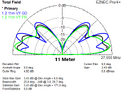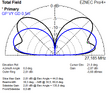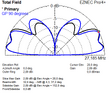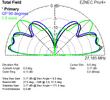Hello,
Possibly there are situations where it isnt always true that the higher we place the vertical antenna...the lower your take-off angle will be.
Specifically not, if you have relative good ground around you.
That ground actually playes a significant part.
(it is open to debate what would be significant though hihi).
4NEC2 qualifies "Pastroral, low hills, rich soil typical from Dallas, RX to lincoln, NE as "very good" ground. (in blue below)
(I also added the pattern of very poor ground (green) and the so called average ground (black)for reference).
If we take a random dipole antenna :
(from :
How high should I place my vertical CB-Antennas.com )

We can see the take-off angle for the very good ground situation is actually higher compared to those with worse ground capabilities.
For very good ground It might be wiser in those situations to leave the antenna near the ground. (for DXing). If we take a tradiational 1/4 wave groundplane with 4 radials and place it 0,5 meters above that very good ground and we place it 5,5 meters above it we will roughly have :

Where the majority of the signals arrive at a 10-20 degree angle the low placed vertical groundplane actually has an advantage over the higher placed one.
(for very good ground).
If it were me, i always worry about take-off angle.
As im into 'DXing", but ill admit ..perhaps im a bit over excited.
It is without a doubt during the solar peaks, you are able to work anything with a mobile antenna. The advantage of take-off angle becomes clear when propagation is not in your favor and you only have a small window of opening.
Then it really is the case of beeing able to work that special DX ....or not.
Perhaps that is the "key" to any conclusion or contribution....
If you find several dB's to be significant or not....but that is up to you.
Kind regards,
Henry





